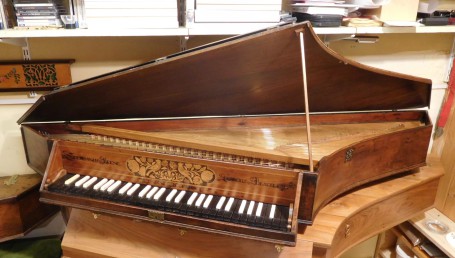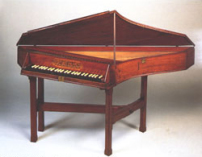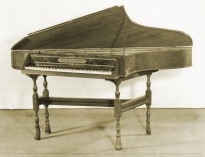
Plans and Designs
UPDATE TO PLAN AVAILABILITY
The famous Keene and Brackley spinet is rightly the model for many reproductions, both amateur and professional. I am happy to announce that by courtesy of the copyright owner of John Barnes' plan, we are now able to offer copies of the plan at an affordable price. Copies are now available through Friends of Square Pianos for just £20, plus carriage.
Please note that this is the original plan taken from the original instrument in the picture, not the EMS kit version which had two added sharps for GG# and d3#.
Please contact me, David, on friends.sp@btinternet.com
Payment by PayPal preferred.
It was recently my privilege to undertake what we hope will be the definitive restoration to return the original to playing condition before its transatlantic journey. It is now an active exhibit in the Sigal Music Museum, South Carolina.
During this work, I got to know the instrument well, and I will be happy to answer any questions.
Please note that many more photographs (including interior detail from an earlier restoration) may be seen on Peter Barnes's website
https://www.peterbarnesharpsichords.com/
But whatever you do, please buy a copy of John Barnes' excellent booklet 'Making a Spinet by Traditional Methods' (see previous page 'General Points'.) This booklet relates directly to the plan.
************************
EDWARD BLUNT 1704
The restoration of the historically important Blunt spinet offered a rare opportunity for me to measure and record the instrument, including the interior structure. I drew a full-sized plan to help with the construction of the replica. I should emphasise that this is not a fully-detailed plan, but I am offering copies for just £15. However, I would recommend that anyone considering making a replica should also obtain a copy of the Keene & Brackley plan, as well as John Barnes excellent booklet.
Edward Blunt was Stephen Keene's apprentice and later partner for a short while, and their contemporary spinets were virtually identical. So this plan will also serve as a model for any Keene or Keene & Blunt spinet c. 1690 - 1705.
*************************
OTHER OPTIONS
- From the Royal College of Music, a plan of their Anonymous 1708 spinet for £45 + VAT + carriage. This was the basis for my own successful spinet seen on the heading of the Spinet Page. The original has the standard (for the time) compass of GG - d3 with a short and broken octave in the bass. For my own instrument I expanded it to GG, AA -f3 chromatic. Trickier than it sounds - please chat to me if you fancy doing this!
It is possibly worth pointing out that the Hitchcock is quite a bit bigger than the '1708'. Not surprisingly, the Keene & Brackley is in between the two!
There is, of course, another possibility. The construction of all English spinets is basically the same, so if you follow the notes which will gradually be added to this page, you can design your own instrument.
It might help to start with a plan-view photograph of an original; many of these are published in books, catalogues, and on the internet.





